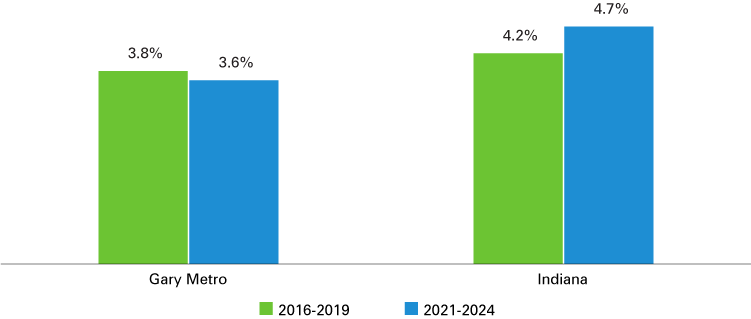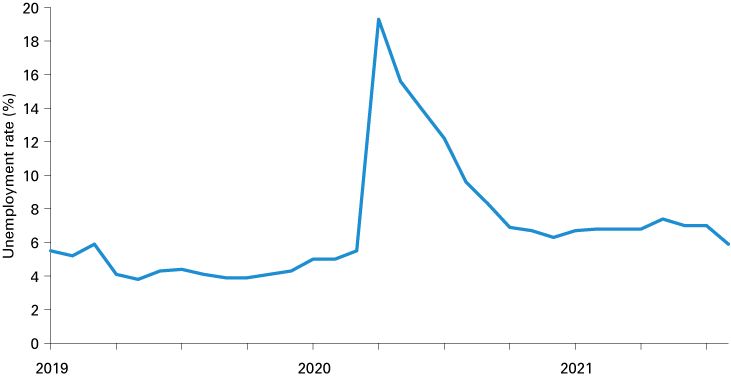Gary forecast 2022

Professor of Economics, School of Business and Economics, Indiana University Northwest
Northwest Indiana is getting its mojo back! There is a sense of optimism in the air.
After a long hiatus, the winds of sanguinity are blowing in Northwest Indiana.1 In 2021, Amazon opened a “last-mile” delivery depot, a 141,000-square-foot warehouse in Merrillville, and Domino's Pizza broke ground for a supply chain center, a 110,000-square-foot facility at the Ameriplex at the Crossroads business park (also in Merrillville). Amazon is likely to bring 300 jobs and Domino’s another 140 jobs. Amazon has invested more than $30 million in land, building and equipment for the facility. The Dominos facility will bring an investment of about $48 million.
In early 2021, Indiana’s newest land-based casino, the $300 million Hard Rock Casino Northern Indiana, celebrated its grand opening in Gary. University of Chicago Medicine is planning an expansion in Crown Point, with a 116,000-square-foot medical facility and a micro-hospital beginning in 2022. And the housing market in Northwest Indiana is skyrocketing, with more people wanting to move into the region to escape Illinois’ higher property taxes and cost of living. Northwest Indiana is back in business.
Northwest Indiana is no longer just the home of steel mills and large manufacturing, but increasingly a place where small businesses find a business-friendly climate and a wealth of local resources to them help them succeed and thrive. Small business is a big business now in Northwest Indiana. Availability of talent from three local universities provide a ready workforce for both traditional and new technology-oriented businesses. The Northwest Indiana Forum (NWI Forum), Indiana Economic Development Corp. (IEDC), Northwest Indiana Small Business Development Center (Indiana SBDC) and Northwestern Indiana Regional Planning Commission (NIRPC) provide excellent resources and support for small businesses and promote entrepreneurship, bringing economic development to the region.
Parts of Northwest Indiana, commonly referred to as Chicagoland, are now also being known as the eastern suburbs of Chicago. While the residents of the four-county Gary Metropolitan Division (referred to in this article as the Gary metro for simplicity) already enjoy several benefits from their proximity to Chicago, the real transformation is about to happen with two huge projects that involve improvements to commuter rail service in Northwest Indiana: the expansion of West Lake Corridor and double tracking of the South Shore Rail. The two projects will provide faster access to Chicago and bring enormous development opportunities for the Gary metro and surrounding areas. According to the Northwest Indiana Regional Development Authority, the two projects have enormous long-term impact by adding about 6,000 new jobs and $3 billion in economic impact by 2048.
Population
According to the 2020 census by the U.S. Census Bureau, the Gary metro has 718,663 residents, an increase of about 10,000 since the last census in 2010. Gary is the second most populous metro area in Indiana and it makes up about a tenth of Indiana’s entire population (see Table 1). If we look closely at the population trend in all the four counties that make up the Gary metro region, the two rural counties (Jasper and Newton) are losing population, while Lake and Porter (the more urban counties) have shown population growth—a trend also observed nationwide in the 2020 census.
Table 1: Census population counts
| Lake | Porter | Jasper | Newton | Gary metro division | Percent of Indiana population | |
|---|---|---|---|---|---|---|
| April 1, 2020 | 498,700 | 173,215 | 32,918 | 13,830 | 718,663 | 10.6% |
| April 1, 2010 | 496,005 | 164,343 | 33,478 | 14,244 | 708,070 | 10.9% |
Source: U.S. Census Bureau
In the past few years, this region has seen population increases in this area. The message of “better quality of life at lower cost of living in the proximity of Chicago” is finally having an impact. The increase in population in the region is largely due to net domestic migration2 as more people chose to move into these Northwest Indiana counties than out of them.
The 2021-24 forecast3 shows the increase in population is likely to continue at a positive rate of 0.2% and should bring more economic momentum to our region.
Homeownership and access to digital resources
The net migration to Northwest Indiana has brought a big boom to the housing and real estate market. The small communities of St. John, Crown Point, Munster and Valparaiso, with their well-maintained and walkable downtowns and great school districts, have attracted a huge number of new households to the area.
According to data from QuickFacts,4 the owner-occupied housing unit rate for counties in the Gary metro ranges from a low of 69.7% in Lake County to a high of 77.9% in Newton County. All four counties are higher than the state’s 69.1% and a lot higher than the U.S., which is a mere 64%. There are a lot of disparities between cities like St. John, with a 97% homeownership rate, and cities like Gary, which has a very low rate of 51%. Roughly 90% of the households in the Gary metro own a computer and about 80% of households have broadband. Overall, the data indicate how the regions’ businesses and students could manage work and study from home during the pandemic from March 2020 till now.
Income and growth forecast
Overall, the income data for the Gary metro shows a brighter picture as compared to the state. Median household income5 for Porter ($71,152) and Jasper ($63,892) counties for 2015-19 (in 2019 dollars) was higher than the national median income of $62,843. Indiana’s median income was $56,303, which was lower than median incomes for Lake ($56,128), Jasper and Porter counties. Only Newton County ($55,356) in the Gary metro was slightly lower than the state.
The forecast for personal income for the Gary metro shows continued growth over the next three years. It is likely to increase from over $38 billion to more than $41 billion. Northwest Indiana has seen good growth despite the coronavirus crisis because a lot of federal funds poured into the local economy in the form of stimulus funds, as well as various forms of incentives and tax credits. With some federal programs likely to end in 2021, 2022 will see a much smaller growth rate in personal incomes. This phenomena of lower growth in incomes for 2022 is likely to happen across the entire state.
Figure 1: Average annual income growth forecast

Source: Indiana University Center for Econometric Model Research, September 2021
The average growth rate for the next three years (2022-24) is likely to be 3.6%, slightly lower than the 2016-19 average. The rate of growth for Indiana is a healthy 4.7%. Some of the other regions, such as Indianapolis, Columbus, South Bend, Elkhart, Lafayette and Anderson, are likely to perform better than the state.
Unemployment trends
Figure 2 shows the monthly unemployment rate trend in the Gary metro over the last 36 months. 2020 was a challenging year, as the nation faced an unprecedented public health crisis, shut down for several weeks and experienced other restrictions for an extended period of time. The unemployment rate peaked at 19.3% in April 2020, but quickly rebounded as businesses reopened and was down to 6.3% by December 2020.
Figure 2: Monthly unemployment rates for the Gary metro

Note: Data are shown through August 2021 and are not seasonally adjusted.
Source: U.S. Bureau of Labor Statistics, Local Area Unemployment Statistics
In 2021, the regional unemployment rate has been sticky and hovering around 7%, a lot higher than the state, which has been in the 4.0%-4.5% range. It will likely take some time to return to the pre-pandemic levels of less than 4%.
Employment forecast
Looking at the current employment trends, jobs have returned to leisure and hospitality, mining and logging, manufacturing, and construction. By April 2021, leisure and hospitality saw a significant growth of more than 58% over the previous 12-month period and construction jobs rebounded by 14%. Table 2 shows the breakdown of employment by selected industry groups from April to September 2021.
Table 2: Gary metro employment for selected industries, 2021 (in thousands)
| Industry | April | May | June | July | August | September |
|---|---|---|---|---|---|---|
| Construction | 14.8 | 15.0 | 14.6 | 14.4 | 15.1 | 14.8 |
| Manufacturing | 33.3 | 33.6 | 33.8 | 34.1 | 33.8 | 33.7 |
| Trade, transportation and utilities | 57.2 | 57.6 | 57.9 | 57.9 | 58.2 | 57.6 |
| Professional and business services | 22.8 | 22.8 | 22.8 | 23.8 | 24.0 | 23.9 |
| Education and health services | 46.3 | 46.4 | 46.9 | 46.6 | 46.7 | 47.5 |
| Leisure and hospitality | 30.1 | 31.0 | 31.7 | 31.8 | 31.6 | 30.9 |
| Government | 31.2 | 31.2 | 31.1 | 27.8 | 29.3 | 31.0 |
Source: U.S. Bureau of Labor Statistics, Current Employment Statistics (CES)
The seven industries listed here account for 92% of all nonfarm jobs in Northwest Indiana and have shown a decent increase in jobs in 2021 as compared to the second quarter of 2020. The trade, transportation and utilities sector and the education and health services sector combine to account for well over 100,000 jobs, which is more than 40% of all nonfarm jobs. This reinforces the notion that we are no longer a region with only steel mills and manufacturing jobs. While we have seen that jobs have rebounded, total jobs are well below the pre-pandemic level of more than 350,000 and they are unlikely to return to that level anytime soon.
The outlook for total annual employment for the next three years (2022-24) is promising.6 It is expected that total employment in the Gary metro will reach nearly 336,000 in 2022—an impressive annual growth rate of 2.6%. Growth in jobs will be at a slower pace (less than 1%) during 2023 and 2024. The overall growth rate in employment for the next three years is 1.3%, slightly lower than the growth in jobs for the state as a whole, but higher than the employment growth in the Muncie, Kokomo, Terre Haute and Anderson regions.
The strong increase in employment expected in 2022 is due to the improved public health situation and new job opportunities. Several new businesses and projects are coming to Northwest Indiana, like the two logistics and warehouse facilities for Amazon and Domino’s Pizza. The other big reason is that the federal support for unemployment programs has ended and people will need to return to jobs for livelihood. Local businesses are already looking to hire workers. The demand for labor is not just seasonal due to the upcoming holidays—it is a real increase in jobs. “Now hiring or “help wanted” signs are visible in every shopping center and all businesses. Emails and phone messages keep popping up for individuals from various recruiters for jobs with $25-$50 per hour and other incentives. It is a good situation to be in for all job seekers.
Notes
- In this article, we focus on the Gary Metropolitan Division, a four-county region that includes Lake, Porter, Newton and Jasper counties. Usually the term “Northwest Indiana” refers to the seven-county region of Jasper, Lake, LaPorte, Newton, Porter, Pulaski and Starke counties. The economic trends are broadly similar and we use the term “Northwest Indiana” to refer to the Gary Metropolitan Division.
- Migration data are available at www.stats.indiana.edu.
- Forecasts come from the Indiana University Center for Econometric Model Research (https://ibrc.kelley.iu.edu/analysis/cemr/), September 2021.
- QuickFacts data are available at www.census.gov/quickfacts/fact/table/US/PST045219.
- QuickFacts data for the region are available at www.census.gov/quickfacts/fact/table/portercountyindiana,lakecountyindiana,newtoncountyindiana,jaspercountyindiana,US/PST045219.
- See note 3.



